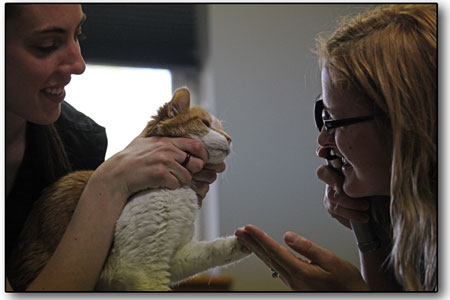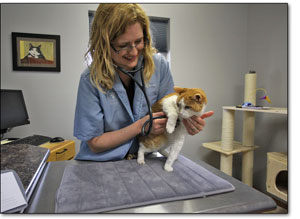 Veterinary nurse Kelli Nash, left, and Dr. Jessica Brooks, right, check up on “Sister,” an 18-year-old cat, at Riverview Animal Hospital recently. More and more local vet clinics are catering to cats and their owners in an effort to get them in before little problems turn into big ones. There is even a local certified cat behavior consultant./Photo by Stephen Eginoire |
The cat came back
Services for Durango’s feline – and feline-loving – residents on the rise
by Jen Reeder
There’s no question that Durango is a dog-friendly town – the Durango Area Tourism Office even ran a campaign last summer promoting Durango’s dog-friendly establishments. But an increase in local services for felines is drawing praise from cat lovers.
Durango resident Tracy Korb has owned Milo, a grey tabby, for 10 years and Padgie, a deaf tabby, for 3½ years and considers them “like family.” She said pet stores used to be almost entirely geared for dogs, but now they carry hundreds of toys for cats and even special products like cat “condos” (large scratching posts with several platforms).
“It’s a good trend to see more cat services locally and nationally,” Korb said.
Still, when she and her husband adopted a black Lab last year, they were surprised by the level of enthusiasm friends and colleagues expressed – much more than they’d ever received for their cats. She said she thinks there is a misconception that cats don’t automatically like people, while dogs do.
“I think cats are misunderstood because our cats are very friendly – they come to the door (to greet us) along with the dog,” she said.
Korb was happy to learn that a cat trainer, a.k.a. certified cat behavior consultant, is one of the new owners of Durango Dogs, and that the dog training company’s name has changed to Durango Dogs (and Cats!) to reflect the addition of services for cat owners.
Co-owner Tonya Sakadinsky, who is certified with the International Association of Animal Behavior Consultants, said she has been fascinated by cats since she studied bobcats in college in the 1990s. She wanted to specialize in cats because so many other people were training dogs.
“Animal behavior in general is my passion, and cats are in dire need,” Sakadinsky said.
She said Durango has always had cat lovers, but more are moving here from big cities where a cat might be a more practical pet in a high-rise building. She helps clients with cats exhibiting behavior issues that can lead to them being surrendered to shelters, such as not using a litter box, aggression with new pets, extreme anxiety from seeing bears outside the window, and scratching furniture.
Sakadinsky works with cat owners to understand feline behavior (“a tail wag on a cat is very different from a tail wag on a dog”) and enrich their environment with toys to keep them from boredom. She also collaborates with veterinary professionals to rule out underlying medical causes for behavior issues, so she applauds the rise in veterinarians offering cat-friendly services and pursuing certification as a “Cat Friendly Practice” with the American Association of Feline Practitioners (AAFP).
 In an effort to minimize stressful vet trips for cats many clinics employ “Cat Friendly Practices,” such as separate examining rooms and pheronome diffusers./Photo by Steve Eginoire |
Heather O’Steen, executive director of the AAFP, said the organization launched the Cat Friendly Practice program in 2012 in response to alarming statistics about cat veterinary visits. For example, although there are millions more pet cats than dogs in the United States, cats are twice as likely to never go to a vet. She said studies found 39 percent of cat owners only visit a veterinarian if their cat was sick, 41 percent only go for vaccinations, and 60 percent said their cat hates going to the veterinarian.
“Many cat owners find the visit to the veterinarian to be a very stressful experience for both them and their cat. This includes the time preparing for the visit, which can consist of trying to coax their cat out from under furniture, trying to get them inside the carrier, and then the yowls and cries during the car ride on the way to the veterinary practice,” O’Steen said.
So a key component for certification as a Cat Friendly Practice involves mitigating stress for cats so that owners are more likely to take their cats to a vet.
Karyn Ekola, hospital manager at Riverview Animal Hospital, said the practice was certified as a Cat Friendly Practice in January 2013. To decrease stress for feline patients, Riverview’s “Feline Task Force” created a private room for cats with a separate entrance and added feline pheromone diffusers to exam rooms (the scent has a calming effect). Staff was also trained on stress-reducing handling techniques, and the clinic hands out brochures from the AAFP with tips on getting cats to the vet as well as a free pheromone wipe for the carrier.
Ekola said thanks to taking steps to become cat-friendly, some patients formerly flagged as aggressive now allow the veterinary team to perform more in-depth exams, including drawing blood.
“If the kitty is less stressed, they allow us to do more, and that allows the doctor to do a more thorough physical examination,” she said. “Cats are prone to a lot of conditions – dental disease, diabetes, kidney and thyroid conditions – that can be cured or managed with early detection. Just a checkup once or twice a year is the most important thing an owner can do for a kitty.”
Durango resident Mary Rieke said Riverview’s cat-friendly services, such as the separate entrance for cats and dim lighting and soft blankets in the room, have made a real difference for her feral cat Orion, a red tabby who used to scratch during visits.
“I have been taking animals to the vet for the past 40 years and generally taking a cat to the vet means you wear a leather jacket and expect to lose it – to have extra holes in it – because the cat stresses out,” Rieke said. “But when Orion goes (now), he doesn’t quite purr, but he’s a mellow fellow.”
Jennifer Schoedler, DVM and owner of Alpine Animal Hospital, is a member of the AAFP and has started the application process to become a Cat Friendly Practice. (She’s passionate about cats – she has two at home and two that live at her practice.) Some of the ways she tries to minimize stress for feline patients include immediately taking cats into a room to avoid interacting with dogs, initially ignoring the cats while talking slowly and quietly with owners in exam rooms, examining cats in their carriers (or conversely, letting them explore the room first), and making house calls when necessary.
She also talks to owners about ways to get their cats used to their carrier, such as leaving it out at home in an accessible place with a comfortable blanket, catnip and treats inside, and possibly taking the cat on car rides that don’t involve a visit to an animal hospital.
She said routine veterinary care is crucial to helping cats live long, healthy lives; cats can live to be 20 years old with early detection of health problems.
“Cats are amazing animals ... they’re very tough. They heal from really pretty serious issues. And the sooner we catch those things, the better chance we have of fixing them,” Schoedler said. “Cats are just such great pets.”
For a free video on tips to overcoming “carrier barrier,” visit www.catalystcouncil.org. For more information about Cat Friendly Practices, visit www.catvets.com/cfp/cfp.
